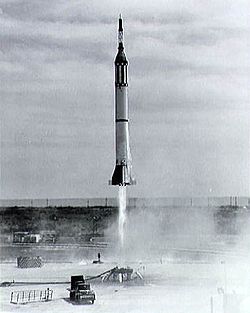
Mercury-Redstone BD
Encyclopedia

Mercury program
Mercury Program might refer to:*the first successful American manned spaceflight program, Project Mercury*an American post-rock band, The Mercury Program...
. It was launched on March 24, 1961 from Launch Complex 5
Cape Canaveral Air Force Station Launch Complex 5
Launch Complex 5 was a launch site at Cape Canaveral Air Force Station, Florida used for various Redstone and Jupiter launches.It is most well known as the launch site for NASA's 1961 suborbital Mercury-Redstone 3 flight, which made Alan Shepard the first American in space. It was also the launch...
at Cape Canaveral
Cape Canaveral Air Force Station
Cape Canaveral Air Force Station is an installation of the United States Air Force Space Command's 45th Space Wing, headquartered at nearby Patrick Air Force Base. Located on Cape Canaveral in the state of Florida, CCAFS is the primary launch head of America's Eastern Range with four launch pads...
, Florida
Florida
Florida is a state in the southeastern United States, located on the nation's Atlantic and Gulf coasts. It is bordered to the west by the Gulf of Mexico, to the north by Alabama and Georgia and to the east by the Atlantic Ocean. With a population of 18,801,310 as measured by the 2010 census, it...
. The mission used a boilerplate Mercury spacecraft and Redstone MRLV-5.
After the problems that developed during the MR-2
Mercury-Redstone 2
Mercury-Redstone 2 was an American space mission, launched at 16:55 UTC on January 31, 1961 from LC-5 at Cape Canaveral, Florida. Mercury spacecraft No...
mission carrying the chimpanzee Ham, it was apparent that the Redstone
Mercury-Redstone Launch Vehicle
The Mercury-Redstone Launch Vehicle, designed for NASA's Project Mercury, was the first American manned space booster. It was used for six sub-orbital Mercury flights from 1960–61; culminating with the launch of the first, and 11 weeks later, the second American in space.A member of the...
needed further development before it could be trusted to carry a human passenger.
Dr. Wernher von Braun
Wernher von Braun
Wernher Magnus Maximilian, Freiherr von Braun was a German rocket scientist, aerospace engineer, space architect, and one of the leading figures in the development of rocket technology in Nazi Germany during World War II and in the United States after that.A former member of the Nazi party,...
added Mercury-Redstone BD to the launch schedule between the MR-2 and MR-3 missions.
The cause of previous Redstone rocket over-accelerations was a servo valve that did not properly regulate the flow of hydrogen peroxide to the steam generator. This in turn overpowered the fuel pumps. The thrust regulator and velocity integrator were modified on the MR-BD and later Mercury-Redstone rockets to prevent them from exceeding the speed limit again.
Another problem encountered in previous Mercury-Redstone flights were harmonic vibrations induced by aerodynamic stress in the topmost section of the elongated Redstone. To fix this problem, four stiffeners were added to the ballast section and 210 pounds (95 kg) of insulation was applied to the inner skin of the upper part of the Mercury Redstone instrument compartment.
The mission used a boilerplate Mercury spacecraft, with inert escape rocket. The spacecraft also did not have a retro package or posigrade rockets.
The MR-BD mission lasted eight minutes and 23 seconds. It reached an apogee of 113.5 miles (183 km) and a range of 307 miles (494 km). The peak velocity was 5,123 mph (8,245 km/h).
The spacecraft experienced a peak load of 11 g (108 m/s²). There was no intention to separate the Redstone rocket and boilerplate Mercury spacecraft and they impacted together 307 miles (494 km) downrange, five miles (8 km) short of the plan. They sank to the bottom of the Atlantic Ocean, exploding a sofar bomb
Sofar bomb
In oceanography, a sofar bomb , occasionally also referred to as a sofar disc, is a long-range position-fixing system that uses explosive sounds in the deep sound channel of the ocean to pinpoint the location of ships or crashed planes...
en route.
MR-BD was highly successful and led the way to the flight of Alan Shepard
Alan Shepard
Alan Bartlett Shepard, Jr. was an American naval aviator, test pilot, flag officer, and NASA astronaut who in 1961 became the second person, and the first American, in space. This Mercury flight was designed to enter space, but not to achieve orbit...
aboard MR-3
Mercury-Redstone 3
Mercury-Redstone 3 was the first manned space mission of the United States. Astronaut Alan Shepard piloted a 15-minute Project Mercury suborbital flight in the Freedom 7 spacecraft on May 5, 1961 to become the first American in space, three weeks after the Soviet cosmonaut Yuri Gagarin had carried...
.
Typical Mercury Redstone sub-orbital flight events
Not flight profile of Mercury-Redstone BD| T+ Time | Event | Description |
|---|---|---|
| T+00:00:00 | Liftoff | Mercury-Redstone lifts off, onboard clock starts. |
| T+00:00:16 | Pitch Program | Redstone pitches over 2 deg/s from 90 deg to 45 deg. |
| T+00:00:40 | End Pitch Program | Redstone reaches 45 deg pitch. |
| T+00:01:24 | Max Q | Maximum dynamic pressure ~575 lbf/ft² (28 kPa). |
| T+00:02:20 | BECO | Redstone engine shutdown - booster engine cutoff. Velocity 5,200 mph (2.3 km/s) |
| T+00:02:22 | Tower Jettison | Escape tower jettison, no longer needed. |
| T+00:02:24 | Capsule Separation | Posigrade rockets fire for 1 s giving 15 ft/s (4.6 m/s) separation. |
| T+00:02:35 | Turnaround Maneuver | Capsule (ASCS) system rotates capsule 180 degrees, to heat shield forward attitude. Nose is pitched down 34 degrees to retro fire position. |
| T+00:05:00 | Apogee | Apogee of about 115 miles (185 km) reached at 150 miles (240 km) downrange from launch site. |
| T+00:05:15 | Retrofire | Three retro rockets fire for 10 seconds each. They are started at 5 second intervals, firing overlaps. Delta V of 550 ft/s (168 m/s) is taken off forward velocity. |
| T+00:05:45 | Retract Periscope | Periscope is automatically retracted in preparation for reentry. |
| T+00:06:15 | Retro Pack Jettison | One minute after retrofire retro pack is jettisoned, leaving heatshield clear. |
| T+00:06:20 | Retro Attitude Maneuver | (ASCS) orients capsule in 34 degrees nose down pitch, 0 degrees roll, 0 degrees yaw. |
| T+00:07:15 | 0.05 g (0.49 m/s²) Maneuver | (ASCS) detects beginning of reentry and rolls capsule at 10 deg/s to stabilize capsule during reentry. |
| T+00:09:38 | Drogue Parachute Deploy | Drogue parachute deployed at 22,000 ft (6.7 km) slowing descent to 365 ft/s (111 m/s) and stabilizing capsule. |
| T+00:09:45 | Snorkel Deploy | Fresh air snorkel deploys at 20,000 ft (6 km). (ECS) switches to emergency oxygen rate to cool cabin. |
| T+00:10:15 | Main Parachute Deploy | Main parachute deploys at 10,000 ft (3 km). Descent rate slows to 30 ft/s (9 m/s) |
| T+00:10:20 | Landing Bag Deploy | Landing bag deploys, dropping heat shield down 4 ft (1.2 m). |
| T+00:10:20 | Fuel Dump | Remaining hydrogen peroxide fuel automatically dumped. |
| T+00:15:30 | Splashdown | Capsule lands in water about 300 mi (500 km) downrange from launch site. |
| T+00:15:30 | Rescue Aids Deploy | Rescue aid package deployed. The package includes green dye marker, recovery radio beacon and whip antenna. |

